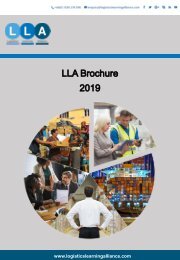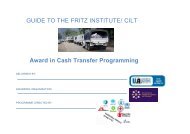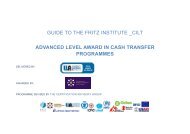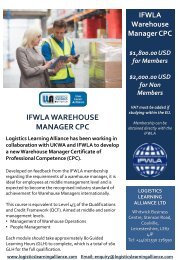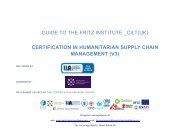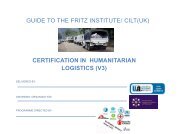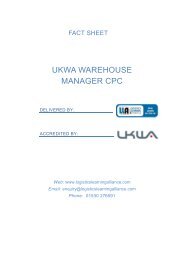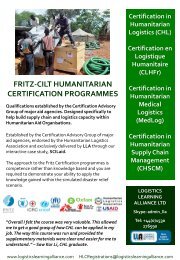CHSCM 3.0 - Unit 1 - SCM in the Humanitarian World
Learning Materials for Unit 1 of the Certification in Humanitarian Supply Chain Management (CHSCM).
Learning Materials for Unit 1 of the Certification in Humanitarian Supply Chain Management (CHSCM).
Create successful ePaper yourself
Turn your PDF publications into a flip-book with our unique Google optimized e-Paper software.
A memorandum of understand<strong>in</strong>g (MOU) is a legal document describ<strong>in</strong>g a bilateral agreement<br />
between parties. It expresses a convergence of will between <strong>the</strong> parties, <strong>in</strong>dicat<strong>in</strong>g an <strong>in</strong>tended<br />
common l<strong>in</strong>e of action, ra<strong>the</strong>r than a legal commitment. It is a more formal alternative to a<br />
gentlemen’s agreement, but generally lacks <strong>the</strong> b<strong>in</strong>d<strong>in</strong>g power of a contract.<br />
A good example of <strong>the</strong> use of MOUs is those signed between <strong>Unit</strong>ed Nations organizations and<br />
NGOs. These MOUs may often be global agreements with International NGOs that describe <strong>the</strong><br />
agreement between both organizations.<br />
It can be used to detail <strong>the</strong> basic pr<strong>in</strong>ciples and guidel<strong>in</strong>es which <strong>the</strong> parties will use to work<br />
toge<strong>the</strong>r to accomplish <strong>the</strong>ir goals. A typical MOU will conta<strong>in</strong> <strong>the</strong> follow<strong>in</strong>g:<br />
• Names of <strong>the</strong> parties<br />
• Timescales and timeframes<br />
• Scope and purpose of <strong>the</strong> MOU<br />
• Signatures of both parties<br />
• Responsibilities of both parties<br />
SLAs and MOUs have traditionally been used <strong>in</strong> relationships between different organizations but<br />
<strong>the</strong>y can also be used to manage relationships between different functions with<strong>in</strong> an organization.<br />
MOUs can def<strong>in</strong>e <strong>the</strong> relationship between <strong>the</strong> functions and a clear understand<strong>in</strong>g of each<br />
function’s commitments/purpose and expectations. SLAs can def<strong>in</strong>e <strong>the</strong> service and service levels<br />
that a supplier function will provide to ano<strong>the</strong>r function.<br />
Earlier, we identified <strong>the</strong> need <strong>in</strong> <strong>the</strong> service level agreement to put <strong>in</strong> place a mechanism for<br />
monitor<strong>in</strong>g and report<strong>in</strong>g on <strong>the</strong> actual service provided. A key part of manag<strong>in</strong>g any relationship is<br />
to make good use of this mechanism. You have probably heard <strong>the</strong> phrase, “If you can’t measure it<br />
you can’t manage it.” This is particularly true at <strong>the</strong> beg<strong>in</strong>n<strong>in</strong>g of a relationship, which is why it is<br />
important that any mechanism is put <strong>in</strong> place immediately so that <strong>in</strong>formation on performance is<br />
available at <strong>the</strong> early stages of <strong>the</strong> relationship. We must not underestimate <strong>the</strong> work that might be<br />
<strong>in</strong>volved <strong>in</strong> putt<strong>in</strong>g this mechanism <strong>in</strong> place. This might <strong>in</strong>volve develop<strong>in</strong>g an IT system that can<br />
capture <strong>the</strong> <strong>in</strong>formation needed, and <strong>the</strong>n process <strong>the</strong> <strong>in</strong>formation <strong>in</strong>to <strong>the</strong> correct format. If <strong>the</strong><br />
mechanism is not <strong>in</strong> place, <strong>the</strong>n ei<strong>the</strong>r <strong>the</strong> <strong>in</strong>formation is not go<strong>in</strong>g to be available or <strong>the</strong>re is a risk<br />
that <strong>the</strong> <strong>in</strong>formation used will not be accurate.<br />
It is difficult for a supply cha<strong>in</strong> relationship to be successful if ei<strong>the</strong>r party is not entirely comfortable<br />
with <strong>the</strong> <strong>in</strong>formation used to assess actual performance and that <strong>the</strong>y can both trust <strong>the</strong> accuracy of<br />
<strong>the</strong> <strong>in</strong>formation.<br />
In <strong>the</strong> early days of any relationship, communication is vital. Experience shows that it is <strong>in</strong> this early<br />
stage that trust will beg<strong>in</strong> to be developed; also misunderstand<strong>in</strong>gs and problems can be identified<br />
and resolved. There is, however, <strong>the</strong> risk of too much communication between <strong>the</strong> two<br />
organizations, and <strong>in</strong>volv<strong>in</strong>g too many people. This is often referred to as <strong>in</strong>formation overload.




